@Brent :
Welcome to the Win-RAID Forum!
This is what I get, when I try to download your zippyshare archive:

Regards
Dieter (alias Fernando)
@Brent :
Welcome to the Win-RAID Forum!
This is what I get, when I try to download your zippyshare archive:

Regards
Dieter (alias Fernando)
@Fernando :
Thanks for the quick reply. I’ve uploaded again to here: https://ozmiui.com/mb_bios_ga-z68x-ud3h-b3_u1n.rar
Regards,
Brent.
@Brent :
According to what I have seen the insertion of the NVMe module has been done correctly.
Good luck!
This is the first time I’ve ever had a need to check out the forums here. I have an ASUS G751JT that I was hoping to upgrade the SSD to something with a larger capacity than the one that came with it. After learning the hard way that NVMe wasn’t support I turned here and found a wealth of information I was able to get my new drive to boot with Win10. Thanks everyone who has contributed to this topic. I’m really excited to be able to get another couple years out of this machine!
In case it’s helpful to anyone else with a similar issue, I ended up going the following route.
1. Updated the firmware to the latest version (213) in my case (did this using ASUS WinFlash and used the latest version from the product downloads page on the ASUS Support site.
2. Used Rufus bootable USB with AFUDOS to get the image currently installed as specified here: https://rog.asus.com/forum/showthread.ph…th-NVMe-Support
3. Loaded the image created with AFUDOS into MMTool and inserted the necessary file as the original post suggests (small version w/compression due to space issues, in my case).
4. Used AFUDOS to reflash the image using to modded file.
I went the AFUDOS route because I kept getting errors from ASUS Easy Flash saying “Invalid BIOS File!! Return to Easy Flash page!!”. I even tried to use WinFlash from the OS just to see if it’d work and it return a similar error.
Just hoping this might help someone else who was having my same issues. Thanks again everyone!
I did see on some mobos and have no idea
You mean your bios boot menu had nothing item about NVME or windows boot manager?Could you take pictures and I am interested in it.
@sose :
Welcome to the Win-RAID Forum and thanks for your feedback!
It is fine, that you succeeded with the BIOS modification, found a way to get the modded ASUS BIOS properly flashed and now are able to boot off the NVMe SSD.
Enjoy it!
Regards
Dieter (alias Fernando)
@gloobox @ryambo:
The start post of this thread makes it very clear, that the NVMe SSD itself (with its manufacturer and model names) will usually not be listed as "Bootable Device" for systems without native NVMe support. The related bootable device is listed as "Windows Boot Manager".
If the user can boot off an NVMe SSD, the entry "Windows Boot Manager" will definitively be shown within the list of the "Bootable Devices". If it is not shown, the user cannot boot off it.
I don’t really need anything but wanted to at least create an account to say thanks to everyone involved who created the guide!
I was able to successfully update the BIOS of my asus m5a99fx pro r2.0 am3+ board to allow Windows 10 to boot from a new WD SN550 NVME drive via use of a PCIex16 slot! My processor and RAM are still more than ample from my last build in 2014 so I didn’t want to really update those if I didn’t need to which made making an NVME drive work with this older board a challenge. You guys had very comprehensive and updated instructions. Even instructions on how to circumvent the security protocols on the EZFlash utility of my board so I could finally get the modded BIOS loaded.
Worked. Like. A. Charm. and saved me the hassle of having to upgrade my board/processor which I didn’t want to do just yet! And the best results are the lighting fast load times I get with the NVME drive over my 10 year old WD 5400 spinner.
Thanks again for doing what you do!
@sunking98 :
Welcome to the Win-RAID Forum and thanks for your feedback!
It makes us happy as well, when users benefit from our discoveries, succeed by following our guides and let us know how grateful they are about the support.
Enjoy the performance of your refreshed old system!
Dieter (alias Fernando)
Unfortunately, it didn’t work and shut down at about 25% when flashing. Lucky for me my board has dual bios and after a bit of time, it eventually recovered from BIOS 2.
I have now dumped the bios and uploaded it hoping you or someone could attempt to insert the nvme module for me.
Thanks in advance,
Brent
dump.rar (2.88 MB)
@Brent :
I am sorry for the BIOS flashing failure. I suspect, that it was not a good idea to delete all DXE Drivers from from the BIOS, which seemed to be Network related.
Since I generally do not modify BIOSes on request, you should create yourself and attach a BIOS, where you have deleted just 1 bigger sized Network EFI DXE driver module and inserted the NVMe module thereafter.
Then I will check it again.
EDIT: After having tried to modify the BIOS myself, here are some tips:
1. Remove just 1 Network related DXE Driver module (e.g. Ip6Dxe).
2. Since the AMI MMTool v4.50 obviously is not able to insert the NVMe module correctly into the BIOS for your specific mainboard (rare issue of the tool), let the UEFITool do it.
3. Check whether there is a natively not present Pad File beneath the inserted NVMe module. If there is one, don’t flash such BIOS!
Look here (left side: Wrong NVMe module insertion, right Pic: Correct NVMe module insertion):
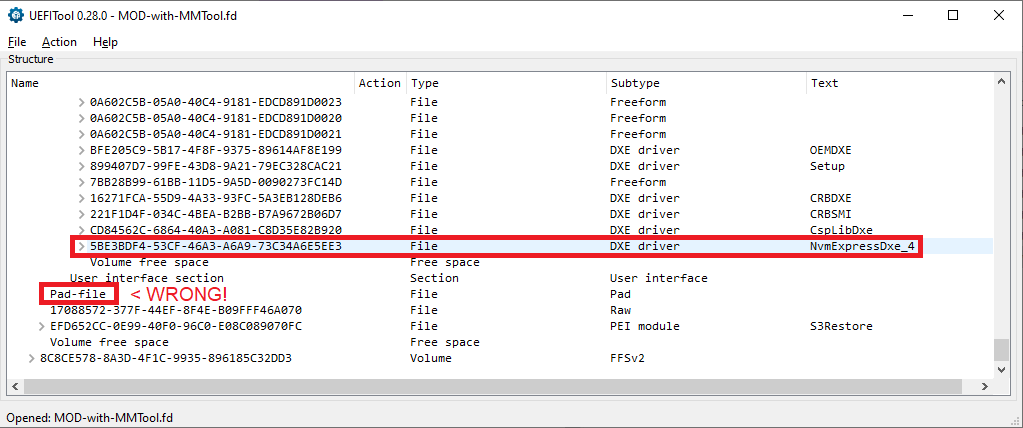
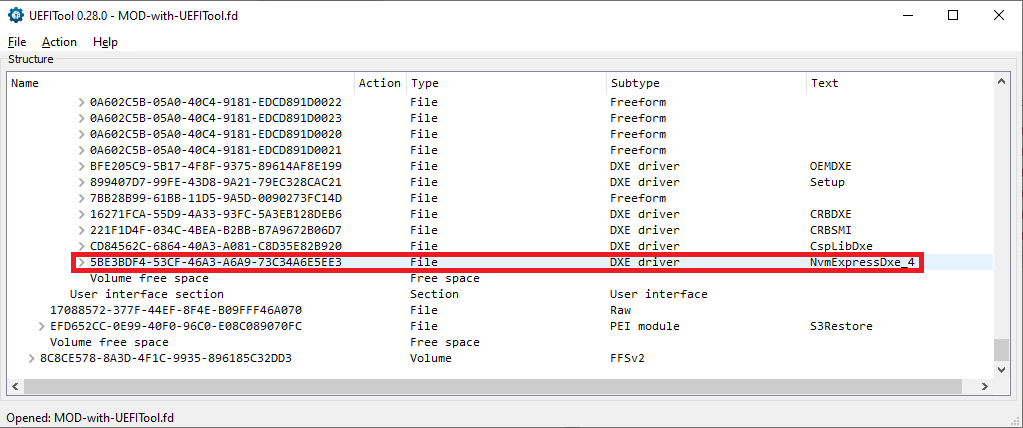
Good luck!
Hi,
I have problems modding the BIOS for the MSI Z77A-G43 GAMING board.
I have tried to add the NVMe module(s) with the UEFITool. There was a pad-file, which has been destroyed by the modding procedure. I have read that this is a sign that it might not work, but as I have the tools to reflash the chip on the board, I have tried anyways. I have tried different modded BIOSes, but after flashing I always get a black screen, no output at all. Restarting the PC and battery reset do not change anything.
I have used the update utility inside the original BIOS to install the modded BIOSes.
I have tried with different NVMe modules:
The one that is recommended in the first post of this thread, an older version of that module, and also modules extracted from the latest BIOS of the Z97-G43 GAMING board. I also tried with a reconstructed pad-file so that the raw data after the inserted NVMe module is on the correct position within the image, but the result was the same.
What works:
The board’s BIOS has an option to load another BIOS from a USB stick. I can tell it to load the modded BIOS, and then I can boot from the NVMe SSD. Still when restarting the PC out of the running Windows, the restart also ends in a black screen. This does not happen, when I power off the PC and then start it again. Then Windows starts successfully again.
This is one of the modded BIOSes I have tested without success:
https://www.file-upload.net/download-141…758IMS.P20.html
The original BIOS is available here:
https://www.msi.com/Motherboard/support/z77a-g43
Can someone tell me which parts of the modded BIOS are bad? Hopefully I am able to write some scripts to fix these parts then.
@lfishere :
Welcome to the Win-RAID Forum!
After having realized, that the UEFITool has removed the Pad-file, why didn’t you follow my guide and took the easiest way by using the AMI MMTool v4.50?
I just have tested it with the latest BIOS v2.13 for your mainboard and the insertion of the uncompressed (“as is”) NvmExpressDxe_4.ffs worked flawlessly. No Pad-file has been destroyed.
Proof:

Regards
Dieter (alias Fernando)
I have guessed that the MMTool is a Windows program, and the only running Windows I have is on the SSD in the computer I want the modded BIOS for, which is not my computer. So I thought, if it is really only the Pad-file, which is destroyed, I can reconstruct it by hand/by script and learn something new.
For that I have analyzed the format of the existing Pad-file (before destruction ;)). The BIOS with my reconstructed Pad-file did not work, unfortunately. Maybe I have made some mistake, maybe something else is also broken, not only the Pad-file. Seems I really have to create a working BIOS with the MMTool and then compare with my version with reconstructed Pad-file, to find out if something else is different.
Thanks for your help so far. If you could send me the BIOS you have created, this would speed up my work and thus be awesome. Otherwise I will have to create one myself.
@Brent : @lfishere :
Please give us your feedback about what you have done and whether you have succeeded or not.
Thanks in advance!
Trillon thx @Fernando , i’ve bought an Adata XPG 8100 % a NVMe-PCIexpress adapter for my ASUS MA97PRO, impressive performance thx to your research & knowledge. For now i’ve made fresh a Windows 10 Pro (2004) that Microsoft sent to my account, just 5,45 minutes for the whole install process. In Seven AdataToolBox gives terribly wrong temp readings, in Win 10 those reads are accurate, but in both systems the Tool Box says “This is not an Adata product”. Just a detail, but i would like to know how to solve this little issue to get the chance for firmware upgrades.
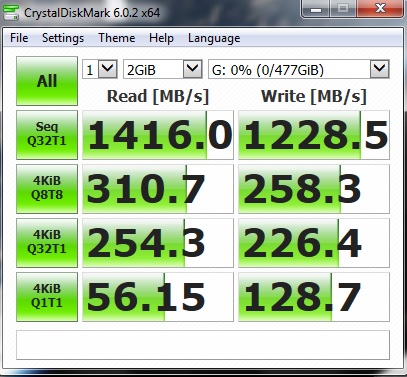
I’ve forget to take benchmarks of Win 10 as main disc, but i have the Win 7 one, as a secondary drive, & are better tan expected.
If you’re asking to me, yes, it works in an Asus M5A97 PRO, at least for Windows 10, like a charm. In a few days i’ll get my Windows Seven cloned to the NVMe, but this is an ítem of another thread.
hi, Fernando, so glad to see this post…
my motherboard is MSI z87 mpower,
I see the warning message from you about the Pad file at the end of the section where CSMCORE is located, and it is in the MSI bios file.
I followed your guide using the MMTool 4.50.0.23
Here is the before / after, does this look good to you? the Pad file is still there after mod ![]()
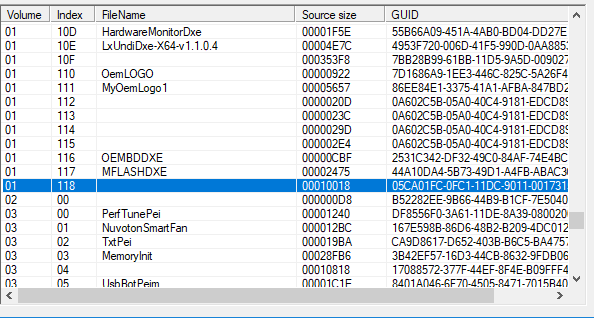
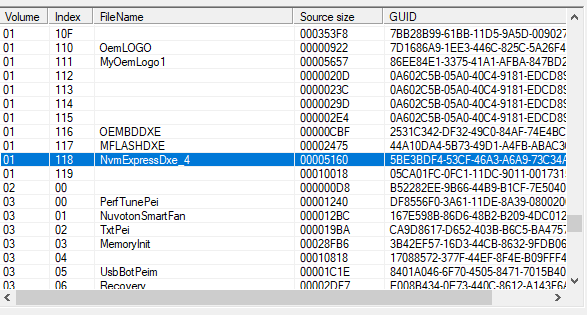
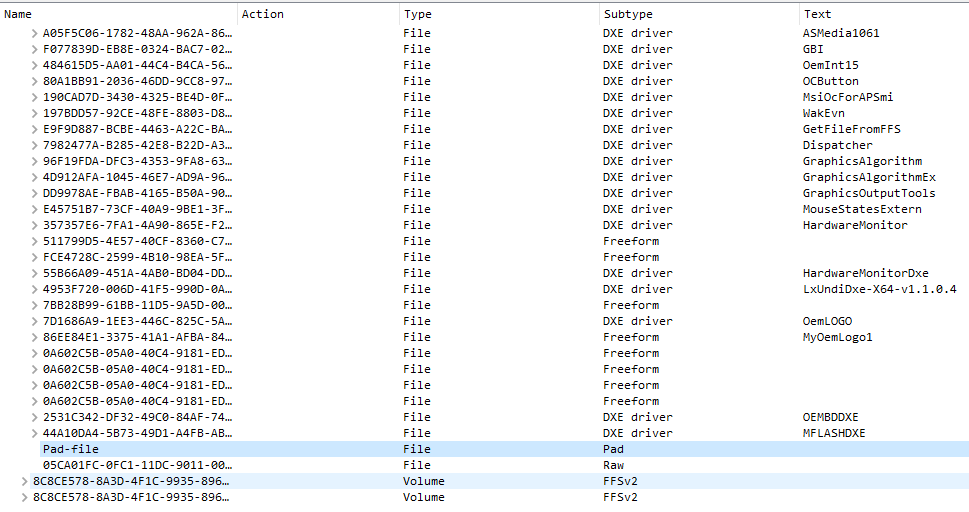
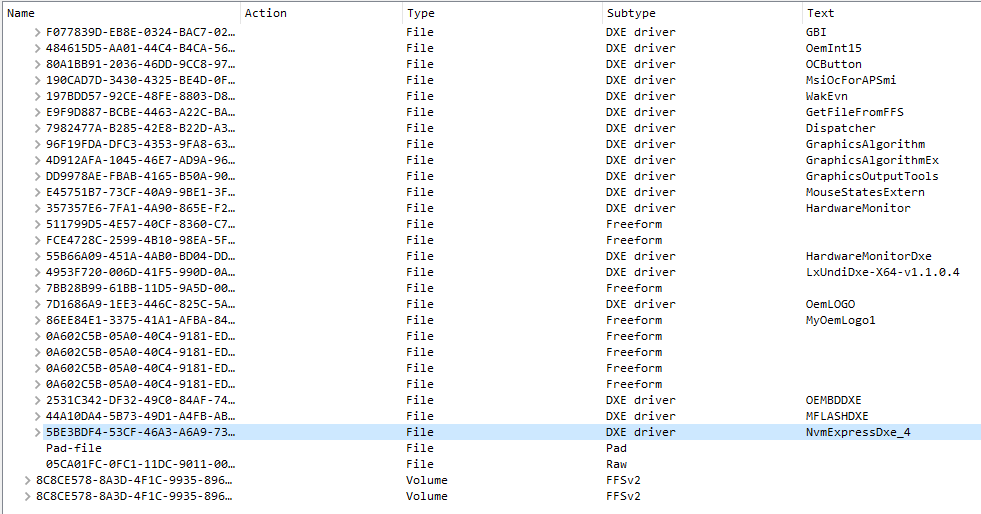
Thank you very much for your help and cannot wait to flash it using MSI M-Flash feature within the BIOS(somewhere I read that it is ok to flash bios within the bios menu)
@ivy037 :
Welcome to the Win-RAID Forum!
According to your inserted pictures the insertion of the NVMe module seems to be well done. Good luck while flashing the modded BIOS!
Regards
Dieter (alias Fernando)
Hi Fernado, one more question…
I just checked the motherboard manual, the board has 3 pcie3.0@16, and it can operate at (16,0,0) or (8,8,0) or (8,4,4)…the other pcie are all @2.0x1 which is not beneficial for nvme…
one pciex16 is being used by graphics card GTX1060. so if i put a pcie x4 adaptor in to another pcie x16 slot, it will operate at (8,8,0) mode right? which means the graphics performance may be reduced?
Thank you very much.